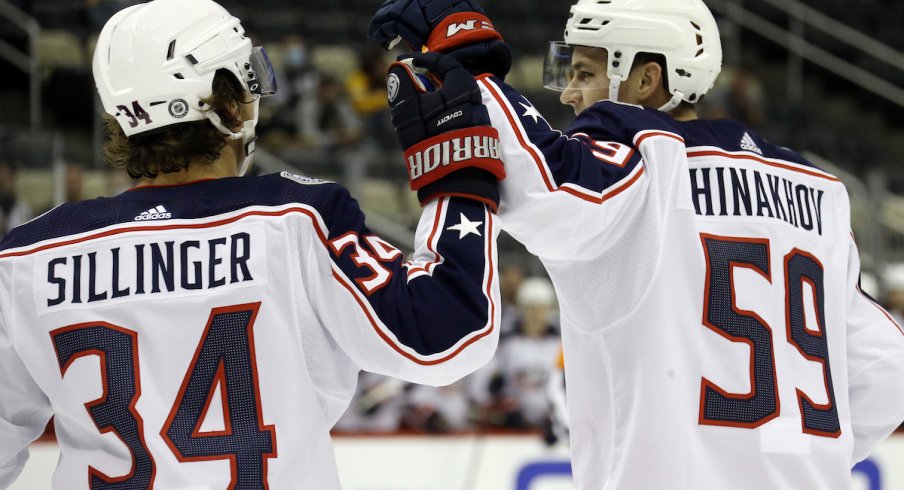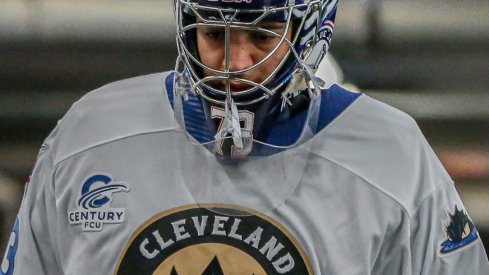October 6, 2020, sure feels like a lifetime ago. That was the first night of the 2020 NHL Draft, where the Columbus Blue Jackets shocked the hockey world by selecting Yegor Chinakhov with the 21st overall pick.
And on July 23, 2021, the first night of the 2021 NHL Draft, the Blue Jackets made more shockwaves throughout the NHL by trading Seth Jones in a blockbuster trade that returned, among others, the first-round pick that minutes later would become Cole Sillinger.
In both instances, the Blue Jackets were hoping to add to 'the next wave' of player within the organization. The future, it turns out, is now.
This season was always supposed to be about development, but that's easier said than done. After all, the easiest part of New Year's Resolutions is setting them. It's the follow-through that presents challenges. The Blue Jackets have said all of the right things as it relates to developing a young roster, but there have been stumbles. Sillinger, 18, was benched for the better part of an entire game in the early goings, and Chinakhov, 20, was made a healthy scratch for nearly two consecutive weeks.
But Saturday night's win over the New Jersey Devils was a clinic in player development, particularly as it relates to these two youngsters.
Chinakhov Goes To The Net
The scouting report on Chinakhov is headlined by his shot. But to make it in the NHL, he has to show an ability to score without using the best club in his bag. He did that against the Devils, scoring a greasy goal playing alongside grinders Sean Kuraly and Eric Robinson.
Kuraly chipped the puck deep and attacked as F1 (first forward in the zone) on the forecheck. Seeing this, Chinakhov went to seal the other side of the net as F2. Realizing that Kuraly was going to win his battle cleanly, Robinson and Chinakhov did exactly as taught, filter to the net. Kuraly spurted the puck to the crease, and Chinakhov was in the perfect position to cash in on the backhand.
It doesn't seem like much, but it's a promising development. Snipers, generally speaking, like to play 'high' in the zone, and along the perimeter of the ice. Going to the front of the net, he was channeling in his inner Boone Jenner. And it paid off with a huge goal.
Sillinger Finishes The Game
Hockey is a global game and many languages are spoken, but everyone understands one common language: ice time. Coaches speak without talking all the time by deploying certain players in certain spots; the inverse is also true.
So it was fascinating to see who Brad Larsen would entrust to hold down the proverbial fort when the Blue Jackets were leading 4-3 late in the third period against the New Jersey Devils.
Sillinger, the youngest player in the NHL, came on the ice with roughly 42 seconds left in the game. He joined the players you would expect to be on the ice: Zach Werenski, Vladislav Gavrikov, Boone Jenner, and Oliver Bjorkstrand. His shift wasn't perfect; he struggled to clear a puck along the wall and turned a puck over at the far blue line. But he gained incredibly valuable experience, which will serve him well now and going forward.
It should be said that, while he didn't finish the game like Sillinger, Chinakhov was also on the ice towards the end of the game. His last shift, in which he played alongside Bjorkstrand and Kuraly, was from 2:22-1:43 left in the third period.
Like Chinakhov's net-front goal, this ice deployment may not seem like a big deal. But for an 18-year old (and to a lesser extent, a 20-year old) to be entrusted to end a game, while your veteran peers sit on the bench... it's certainly notable. And so while this specific game will likely fade from our collective memories, it was a significant game in terms of developing two of the club's brightest young players.
And at the end of the day, that's the goal for this season.

